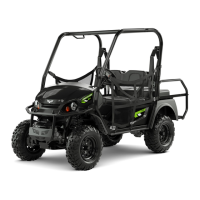MAINTENANCE
33
Prolonged Storage
During periods of storage, the batteries must be maintained to prevent discharge.
In winter conditions, the batteries must be fully charged to prevent the possibility of
freezing. A fully charged battery will not freeze in temperatures above -75° F (-60°
C). Although the chemical reaction is slowed in cold temperatures, the battery
must be stored fully charged, and disconnected from any circuit that could dis-
charge the battery.
The batteries must be cleaned and all deposits neutralized and removed from the
battery case to prevent self discharge.
The battery charger may be left connected to the vehicle to maintain a full charge
on the batteries, provided the charger is plugged into an active electrical source. If
power to the electrical source is disconnected or interrupted, the battery charger
will continue to check the charge on the battery pack. This will draw power from the
battery pack and eventually drain the batteries if power is not restored in a timely
manner.
Battery Charging
The battery charger is designed to fully charge the battery set. If the batteries are
severely deep cycled, some automatic battery chargers contain an electronic mod-
ule that may not activate and the battery charger will not function. Automatic char-
gers will determine the correct duration of charge to the battery set and will shut off
when the battery set is fully charged. Always refer to the instructions of the specific
charger being used.
Before charging, the following should be observed:
Do not overfill batteries. The charging cycle will
expel electrolyte and result in component damage.
• The electrolyte level in all cells must be at the recommended level and cover the plates.
• The charging must take place in an area that is well ventilated and capable of removing the hydrogen gas that is generated by the charging process. A
minimum of five air exchanges per hour is recommended.
• The charging connector components must be in good condition and free from dirt or debris.
• The charger connector must be fully inserted into the vehicle receptacle.
• The charger connector/cord set must be protected from damage and is located in an area to prevent injury that may result from personnel running over
or tripping over the cord set.
• The charger is automatically turned off during the connect/disconnect cycle and therefore no electrical arc is generated at the DC plug/receptacle con-
tacts.
Battery Troubleshooting
In general, troubleshooting will be done for two distinct reasons:
• A battery that performs poorly and is outside of the manufacturers specification should be identified in order to replace it under the terms of the manu-
facturer’s warranty. Different manufacturers have different requirements. Consult the battery manufacturer or the manufacturer’s representative for
specific requirements.
• Determine why a particular vehicle does not perform adequately. Performance problems may result in a vehicle that runs slowly or in a vehicle that is
unable to operate for the time required.
A new battery must mature before it will develop its maximum capacity. Maturing may take up to 100 charge/discharge cycles. After the maturing phase, as
the battery ages, its capacity diminishes. The only way to determine the capacity of a battery is to perform a load test using a discharge machine following
manufacturer’s recommendations
A cost effective way to identify a poorly performing battery is to use a hydrometer to identify a battery in a set with a lower than normal specific gravity. Once
the problematic cell or cells are identified, the suspect battery can be removed and replaced. At this point there is nothing that can be done to salvage the
battery; however, the individual battery should be replaced with a good battery of the same brand, type and approximate age.
1.100
1.120 1.160 1.200 1.240 1.280
1.140 1.180 1.220 1.260 1.300
-9
-15
-21
-26
-32
-37
-43
-48
-54
-60
-65
-71
E
L
E
C
T
R
O
L
Y
T
E
T
E
M
P
E
R
A
T
U
R
E
SPECIFIC GRAVITY ELECTROLYTE FREEZING POINT
O
C
+15
+5
-5
-15
-25
-35
-45
-55
-65
-75
-85
-95
O
F

